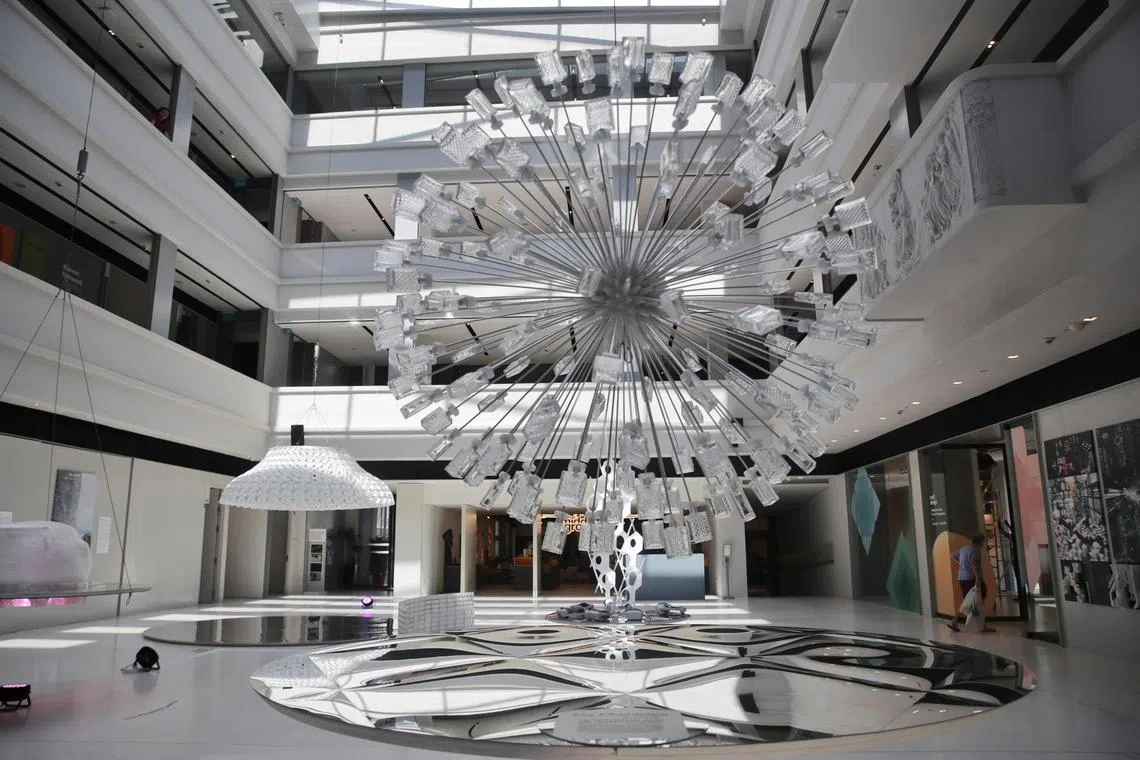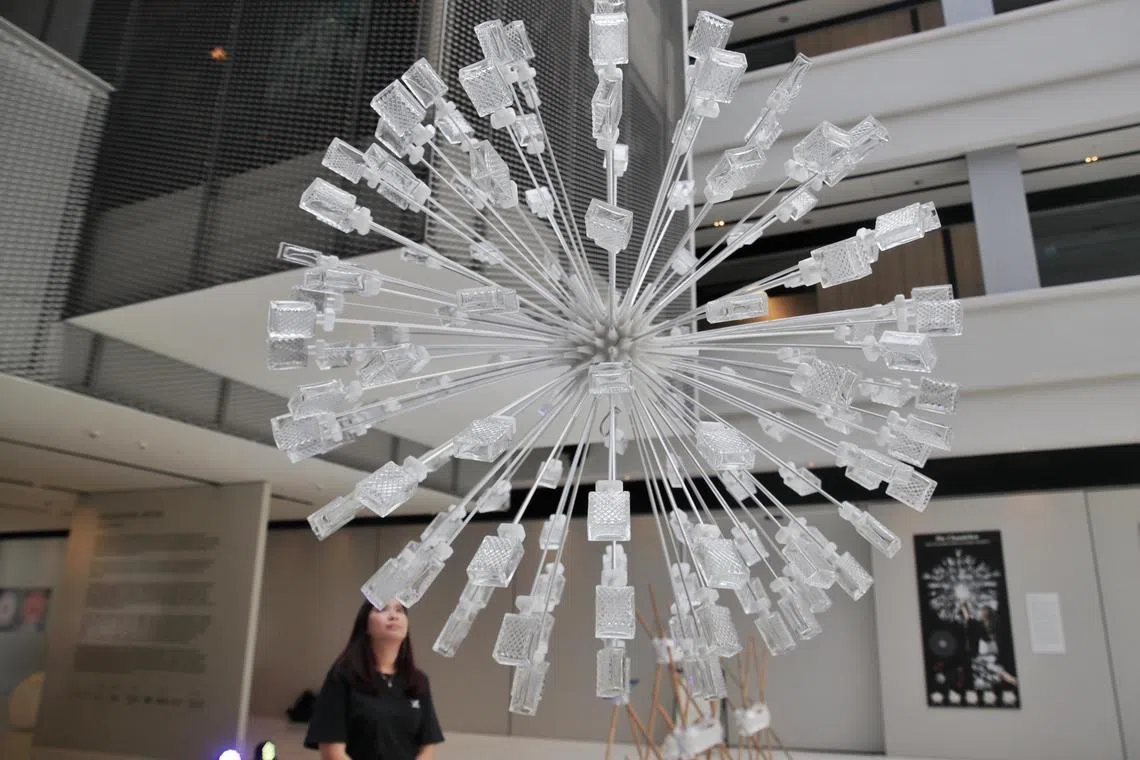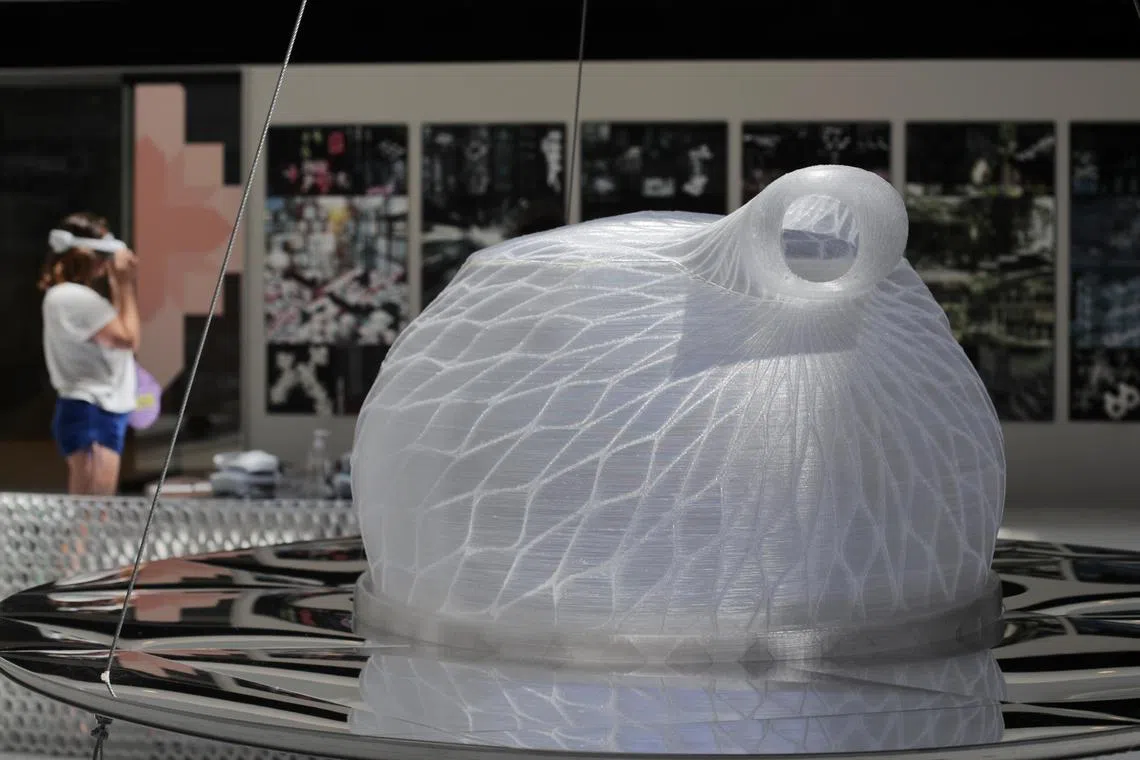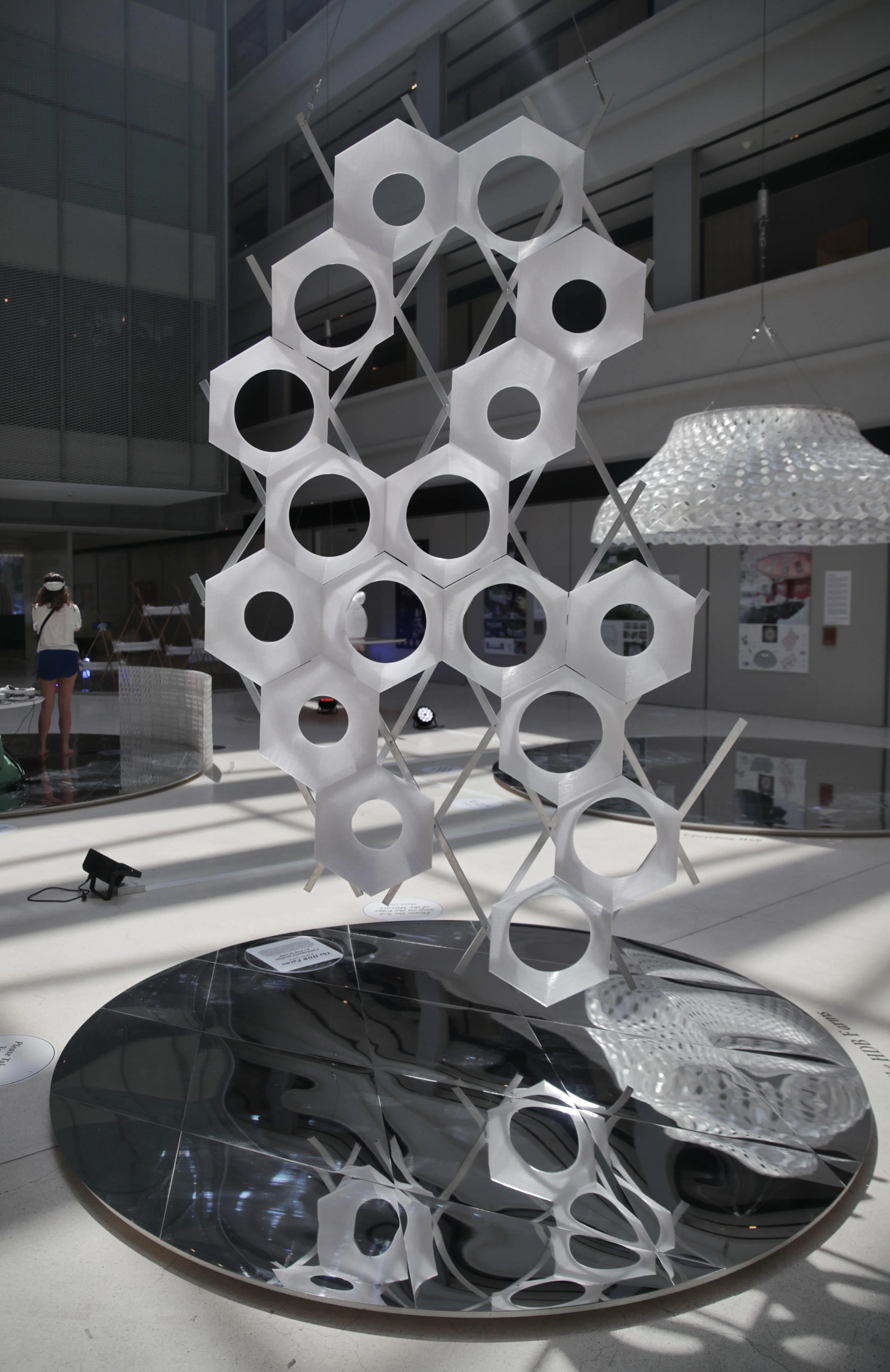Sustainability exhibition Circular Futures: Next Gen shows how waste can be upcycled into luxe design
Sign up now: Get ST's newsletters delivered to your inbox

The Chandelion on display as part of Circular Futures: Next Gen at the National Design Centre.
ST PHOTO: GIN TAY
Follow topic:
SINGAPORE – A new exhibition titled Circular Futures: Next Gen at the National Design Centre showcases a range of tech-driven designs that are reusable and eco-friendly from concept to finished product.
Taking pride of place at the exhibition – which is produced by digital art and technology start-up Artacia and ends on April 9 – is the Chandelion, a spherical chandelier inspired by the humble dandelion.
Approach it and you will see that the structure, which measures 1.5m in diameter, is made up of 153 empty perfume bottles placed at the ends of slim, tubular spokes made from recycled aluminium cans with tiny LED bulbs at the tip.
The chandelier project is just one of many designs being showcased by Architectural Intelligence Research Lab or AirLab, a multidisciplinary research laboratory established at the Singapore University of Technology and Design (SUTD) in Somapah Road.
Led by Professor Carlos Banon, AirLab combines additive manufacturing – also known as 3D printing – with parametric design (algorithm-based design) to reduce wastage and create new aesthetics in architecture.
The stunning Chandelion embodies an important message that the organisers of Circular Futures: Next Gen want to get across: Circularity – making reusable products via a process which is environmentally friendly from start to finish – concerns everyone, not just businesses or governments.
Also called “circular systems” or the “circular economy”, the concept is also key in prolonging the lifespan in the coming years of Singapore’s only offshore landfill for the nation’s trash, the Semakau Landfill in Semakau Island.
The show’s organisers assert that it is now possible to push the boundaries of design and sustainability to go from zero waste to exploring circular systems, emerging technologies and potential solutions.
To stage the exhibition, Artacia’s founder and curator Avantika Malhotra collaborated with SUTD, AirLab and formAxioms, a research laboratory in SUTD which experiments with blockchain, as well as virtual, augmented and extended realities (VR, AR and XR).
“I think the message is that everyone has a role to play,” says Ms Malhotra, who founded the local curatorial studio, which partners with artists and designers, in July 2019.
Involved with the arts for over 25 years in different capacities, the 52-year-old was also an art lecturer at Reading University in Berkshire in the United Kingdom and has a post-graduate diploma in Asian Art from the British Museum.
“While the exhibition showcases how designers are using technology and innovation to convert waste materials into beautiful functional products and create sustainable solutions, the story does not end here.
“We all have a collective responsibility to take this forward,” she says. “We need to start accepting and supporting these products so that everyone involved is incentivised to continue developing sustainable solutions. This is what will create a truly sustainable cycle.”

The Chandelion comprises 153 discarded perfume bottles, which were upcycled with a new central core made of 3D-printed filament produced from used plastic bottles and recycled aluminium tubes.
ST PHOTO: GIN TAY
The exhibition’s collaborators include SUTD, the National Environment Agency (NEA), food and beverage brand F&N Foods, main sponsor DBS Bank, virtual reality firm Pico and the SG Eco Fund. It is supported by Design Singapore Council.
To fabricate the designs – such as stools, vertical farm structures and floating farm pods – more than 150kg of plastic waste made of polyethylene terephthalate (PET) transparent bottles was upcycled into filaments for 3D printing machines.
Part of the plastic waste was collected from the smart Reverse Vending Machines (RVMs) under the Recycle N Save initiative by F&N Foods and the NEA, which was rolled out in October 2019.
Since the launch, more than 13 million plastic bottles and aluminium drink cans have been collected through 50 RVMs across Singapore and from schools.

The Floating Farm Pod can be used in water bodies to maximise farming space and mitigate the environmental effects of land-based farming.
ST PHOTO: GIN TAY
The concept of circular systems is gaining traction as more knowledge of sustainability is being spread throughout the community, observes Professor Tai Lee Siang, SUTD’s head of pillar for architecture and sustainable design.
“A key part of circularity is understanding recycling and reuse,” he says. “Many businesses and consumers are beginning to appreciate the importance of recycling to the environment and they are willing to pay the difference in price.
“However, it is also important to make recycling beautiful and appealing. A new aesthetic is on the rise and many consumer products are building on the edginess of such a concept.”
Prof Tai adds that this is possible only through a mastery of design and craftsmanship, and mature designers are paying attention to the trend. “Circular Futures wows visitors by surprising them with waste that can be transformed into something not seen before.”
AirLab’s director and founder Prof Banon says the use of digital design and fabrication techniques allows for unprecedented precision, complexity and customisation in the design and creation of the prototypes on show.
“The exhibition is a powerful reminder of how technology can be harnessed to create innovative solutions to some of the most pressing issues of our time,” says Prof Banon, 44, who is also an associate professor of Architecture and Sustainable Design at SUTD.

The HDB vertical farm is a participatory envelope design for food security.
ST PHOTO: GIN TAY
The show presents a number of practical solutions that can be implemented within the next 12 months, he adds.
One example is the Upcycled Dining Chandeliers, which have recently been installed in logistics firm DB Schenker’s Red Lion building at Airport Logistics Park Singapore in Changi Airport.
More than 50kg of plastic waste was transformed into lighting fixtures that are not only functional, but also aesthetically pleasing. It was part of a tie-up between AirLab, SUTD, the National Additive Manufacturing Innovation Cluster and DB Schenker to develop designs suitable for domestic and commercial settings, from Housing Board estates to hotels to restaurants.
“Besides making practical, everyday products, it is now also possible through design and technology to add value to throwaway materials by turning waste into luxury products that are affordable as well as eliminating wastage during manufacturing,” adds Prof Banon.
One of the earliest visitors to the exhibition on Jan 6 was Mr Naveen Asrani, 49, who is married and has a 12-year-old son.
A technology and product leader in a global firm, he says sustainability is “critical” to him as a parent.

The Upcycled Dining Chandelier (foreground) comprises hundreds of small tiles 3D-printed from recycled materials such as plastic bottles and cardboard boxes.
ST PHOTO: GIN TAY
“This is the world we will collectively nurture for our future generations, and the exhibition shows us how it can be done – from concept to design to life-size exhibits,” he says.
“The experience was magical as the show also gave me a glimpse of how chandeliers and stools can be repurposed from 150kg of discarded plastic bottles.”
Mr Asrani was so moved by the show that he visited again with his son Pranav, who was “stunned at what he saw”.
Another visitor, Ms Li Yuting, 28, who visited on Wednesday, says the show demonstrates the vast potential of recycling waste materials into visually appealing objects.
“The 3D-printed products made from upcycled plastic materials are an eye-opener,” says Ms Li, who is in Singapore on holiday. She is pursuing a master’s degree in linguistics at Germany’s Free University of Berlin.
Besides prototypes and physical installations, the exhibition also includes speculative designs by graduate students of SUTD’s research lab formAxioms, who created unique infrastructure and solutions for climate change.
Co-founder of formAxioms Eva Castro says visitors can interact with these designs by using a VR headset for a more immersive experience.

FLOAT (farming lab on trough) is a vertical urban farming system with automated irrigation display.
ST PHOTO: GIN TAY
The VR experience allows visitors to explore a future in which circular systems include not only materials, but also governance, social responsibility and economics, in order to tackle problems such as excessive consumerism and the waste it generates.
“The virtual experiences allow us to imagine ‘other’ modes of existence and to think out of the box,” says Prof Castro, 52, who is also Professor of Practice for architecture and sustainable design at SUTD.
“As a society, we are always pressured to resolve problems in the here and now, which can be quite short-sighted. This exhibition helps us to immerse ourselves in other ways of inhabiting our planet and to speculate about how it may work, look, sound and feel,” she adds.
“We want visitors to leave the exhibition hall with a sense that they can still regain their agency to make a change.”
Circular Futures: Next Gen
When: Until April 9, 9am to 9pm circularfutures.sg
Where: Level 1 Atrium, National Design Centre, 111 Middle Road
Admission: Free
Info:
Correction note: In an earlier version of the story, we said that the multidisciplinary research laboratory established at SUTD is called Architectural Intelligence Lab. This is incorrect. It should be Architectural Intelligence Research Lab.


